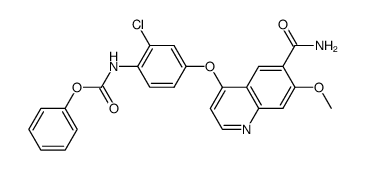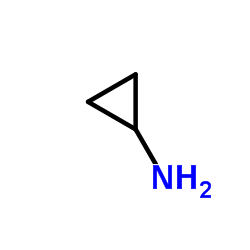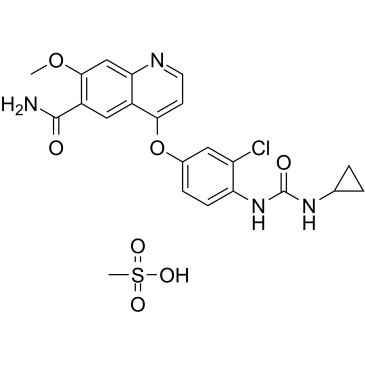Lenvatinib (E7080)
Modify Date: 2025-08-21 09:46:36

Lenvatinib (E7080) structure
|
Common Name | Lenvatinib (E7080) | ||
|---|---|---|---|---|
| CAS Number | 417716-92-8 | Molecular Weight | 426.853 | |
| Density | 1.5±0.1 g/cm3 | Boiling Point | 627.2±55.0 °C at 760 mmHg | |
| Molecular Formula | C21H19ClN4O4 | Melting Point | N/A | |
| MSDS | N/A | Flash Point | 333.1±31.5 °C | |
Use of Lenvatinib (E7080)Lenvatinib is an oral, multi-targeted tyrosine kinase inhibitor with IC50s of 4 and 5.2 nM for VEGFR2(KDR) and VEGFR3(Flt-4), respectively. Lenvatinib is less potent against VEGFR1/Flt-1 and shows approximately 10-fold selectivity for VEGFR2/3 over FGFR1, PDGFRα/β. |
| Name | lenvatinib |
|---|---|
| Synonym | More Synonyms |
| Description | Lenvatinib is an oral, multi-targeted tyrosine kinase inhibitor with IC50s of 4 and 5.2 nM for VEGFR2(KDR) and VEGFR3(Flt-4), respectively. Lenvatinib is less potent against VEGFR1/Flt-1 and shows approximately 10-fold selectivity for VEGFR2/3 over FGFR1, PDGFRα/β. |
|---|---|
| Related Catalog | |
| Target |
VEGFR2:4 nM (IC50) VEGFR3:5.2 nM (IC50) |
| In Vitro | Lenvatinib inhibits KIT kinase with an IC50 value of 100 nM. lenvatinib inhibits SCF- and VEGF-induced tube formation in a dose-dependent manner with IC50 values of 5.2 and 5.1 nM, respectively. Lenvatinib inhibits SCF-induced proliferation of another human SCLC, H526 cells, which expresses KIT, at the concentrations required for the inhibition of KIT kinase. The IC50 values of Lenvatinib against phosphorylation of KDR and KIT in HUVEC are about 500 times lower than those against H146 proliferation in vitro[1]. Lenvatinib inhibits both angiogenesis and lymphangiogenesis induced by human breast cancer cells, and significantly inhibits tumor growth of MDA-MB-231. Lenvatinib and bevacizumab treatment decreases MVD by almost the same extent[2]. Lenvatinib inhibits proliferation at high concentrations (mean IC50s 23.6-44.17 μM) in the majority of the cell lines, while the IC50 in the KM12C colon cancer cell line is 9.54 μM[3]. |
| In Vivo | Lenvatinib inhibits the growth of H146 tumor at 30 and 100 mg/kg (BID, QDx21) in a dose-dependent manner and causes tumor regression at 100 mg/kg in H146 xenograft model. IHC analysis with anti-CD31 antibody shows that lenvatinib at 100 mg/kg decreases microvessel density more than anti-VEGF antibody and imatinib treatment[1]. lenvatinib (100 mg/kg, p.o.) is administeredand bevacizumab significantly inhibits local tumor growth at the m.f.p., and at the end of treatment, lenvatinib also significantly inhibits metastasis to both regional lymph nodes and distant lung[2]. |
| Kinase Assay | Tyrosine kinase assays are performed by HTRF (KDR, VEGFR1, FGFR1, c-Met, EGFR) and ELISA (PDGFRβ), using the recombinant kinase domains of receptors. In both assays, 4 μL of serial dilutions of lenvatinib are mixed in a 96-well round plate with 10 μL of enzyme, 16 μL of poly (GT) solution (250 ng) and 10 μL of ATP solution (1 μM ATP) (final concentration of DMSO is 0.1%). In wells for blanks, no enzyme is added. In control wells no test article is added. The kinase reaction is initiated by adding ATP solution to each well. After 30-min incubation at 30°C, the reaction is stopped by adding 0.5mol/LEDTA (10 μL/well) to the reaction mixture in each well. Dilution buffer adequate to each kinase assay is added to the reaction mixture. |
| Cell Assay | H146 (1.2×103 cells/50 μL/well) in SFM containing 0.5% BSA are cultured in 96-well multi-plates. After overnight culture at 37°C, SFM (150 μL/well) containing 0.5% FBS and several concentrations of SCF are added with or without several concentrations of compound. After culture for 72 hr, the ratios of surviving cells are measured by WST-1. |
| Animal Admin | Female BALB/c nude mice (8-12 weeks old, 20-25 g) are maintained under clean-room conditions. H146 tumor cells (6.5×106) are implanted subcutaneously (s.c.) into the flank region of mice. Twelve days after inoculation, mice are randomized into control (n=12) and treatment (n=6 or n=5) groups and this point in time is identified as day 1. Lenvatinib and Imatinib, and VEGF neutralization antibody are suspended in 0.5% methylcellulose and saline, respectively, and administered orally twice a day for lenvatinib and imatinib and twice a week for antibody from day 1 to day 21. Tumor volume is measured on the indicated days and calculated. Antitumor activity is shown as a relative tumor volume (RTV=calculated tumor volume at indicated days/volume on day 1). |
| References |
| Density | 1.5±0.1 g/cm3 |
|---|---|
| Boiling Point | 627.2±55.0 °C at 760 mmHg |
| Molecular Formula | C21H19ClN4O4 |
| Molecular Weight | 426.853 |
| Flash Point | 333.1±31.5 °C |
| Exact Mass | 426.109497 |
| PSA | 115.57000 |
| LogP | 3.39 |
| Vapour Pressure | 0.0±1.8 mmHg at 25°C |
| Index of Refraction | 1.697 |
| Storage condition | 2-8℃ |
|
~79% 
Lenvatinib (E7080) CAS#:417716-92-8 |
| Literature: EP1698623 A1, ; Page/Page column 15 ; |
| Precursor 2 | |
|---|---|
| DownStream 1 | |
| 4-{3-Chloro-4-[(cyclopropylcarbamoyl)amino]phenoxy}-7-methoxy-6-quinolinecarboxamide |
| UNII-EE083865G2 |
| E7080 |
| MFCD16038644 |
| Lenvatinib |
| 4-[3-chloro-4-(cyclopropylcarbamoylamino)phenoxy]-7-methoxyquinoline-6-carboxamide |
| 6-Quinolinecarboxamide, 4-[3-chloro-4-[[(cyclopropylamino)carbonyl]amino]phenoxy]-7-methoxy- |
| Lenvatinib (E7080) |


 CAS#:857890-39-2
CAS#:857890-39-2
